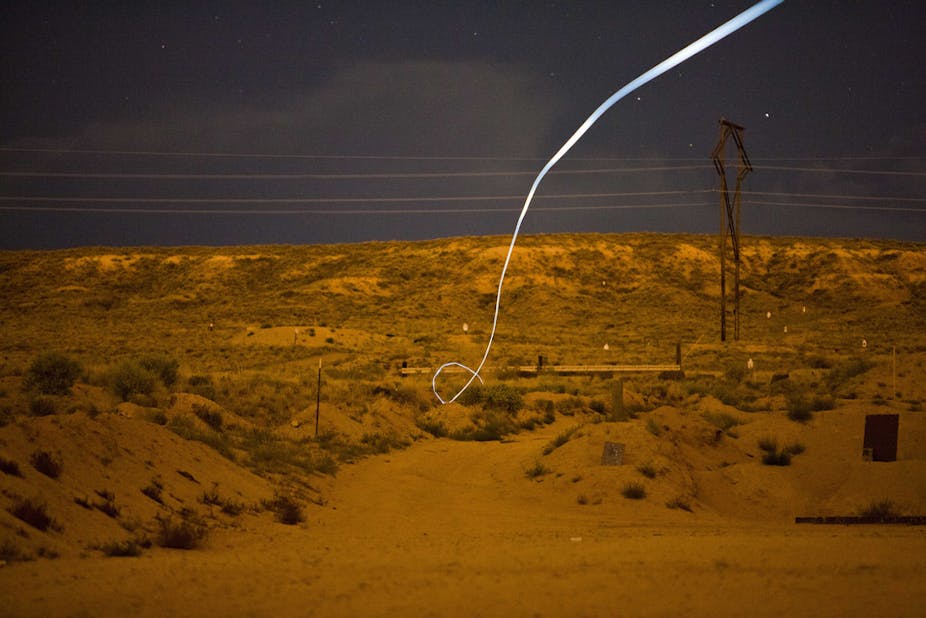At the beginning of this year Sandia Labs in the United States announced it had patented a design for a self-guided bullet that could help soldiers at war. The technology is expected to prevent the need for targeted air strikes that could kill innocent people while criminals take cover in their midst.
This “super” self-guided bullet can hit laser-designated targets accurately to around 2,000 metres. An example of this capability can be found in the XM25 rifle.
To rephrase the Cold War notion of “limited nuclear warfare”, we could now say with these latest developments to the war-fighting repertoire that we have the fundamental means for “limited person warfare”.
Point at your target using the rifle’s laser rangefinder, pull the trigger and walk away assured that the kill has taken place, given the bullet detonates at the exact distance to the “obstruction” or strategically nearby. This technology can overcome trenches or urban theatre barricades such as walls.

It’s no longer a “point and pray” mode of operation. Instead these self-guided bullets use a smart system-on-a-chip imaging sensor that does not rely on GPS to see and confirm a target.
The future of precision-guided munition (PGM) is not just in artillery but could also enhance capabilities of weaponised uninhabited aerial vehicles (UAVs).
It’s that easy … or is it?
Point in question: the “accidental” 1999 bombing of the Chinese Embassy in Belgrade by United States military forces which killed three journalists and injured 20 embassy staff. The CIA later stated in a press release that the positioning technology had functioned correctly but the knowledge systems supporting it had failed.
Can we not say the same for the self-guided bullet and the alleged positive identification of individual targets?
While the mechanics of the smart bullet might lead to a precision strike, how sure can the soldier in the field be that the target in sight is actually the correct one? Might he or she be firing at the wrong target? And how can he or she tell at 2,000 metres away?
The ancient art of concealment means the enemy can “dress up” to avoid detection from short range. We can therefore argue that we have the technology but still lack the necessary knowledge to guarantee the claims of the application.
But the next advancements we may discover are that the self-guided bullet will:
1) be fitted with an infra-red (IR) facial recognition system that can ensure the person being fired at is really the one most wanted
2) detonate with variable degrees of lethality depending on the intended damage
3) have the capability to be redirected or terminated in-flight
Such is the exponential growth of innovation in military technology. It has an insatiable appetite. It is a never-ending cycle with a never-ending solution.
There is a mindset which is common to the laboratory nowadays: because we can, we should; and that with time we can build smarter and increasingly more undetectable weapons than our opposition. As we are discovering, however, “smarter weapons” is as much a contradiction as was “limited nuclear warfare”.
No sooner have we deployed these smart machines in the theatre of war than we turn them on ourselves by commercialising the technology and – potentially – putting it in the hands of the very same people we’re supposed to be fighting.

Law enforcement and the military are currently investing in the potential for spy drones, some the size of mosquitos that can also surveil and attack individual people or homes. This has brought a new meaning to the ideas of reconnaissance and voyeurism.
At what stage does someone give the okay for this personalised attack to begin, and on whom and based on what evidence? These are some of the questions that soldiers might also ask themselves when, in the future, they pull the trigger to send one of those self-guided bullets toward their target.
In the US the Federal Aviation Administration Modernisation and Reform Act of 2012 has paved the way for anyone – including civilians – with the capacity to launch a UAV to do so. This has incredible implications.
We could take the “I don’t care, I have nothing to hide” attitude, as someone recently said to me when discussing this topic because “all they’ll see is me hanging up my washing” … but it’s never that simple.
One of the shortcomings of the embedded, almost-microscopic system-on-a-chip is that, no matter whether it is injected into a person, a munition, or a drone, there is no guarantee, ever, that it will mitigate for human error when it comes to identifying targets.

That’s the idea at the core of überveillance - an omnipresent electronic surveillance facilitated by technology that makes it possible to embed surveillance devices in a living or non-living thing.
Technology can fail, and inevitably will fail, and not solely because it can malfunction. The data collected by any given technology can be misinterpreted by humans, lost in translation or even – in the case of malicious intent – deliberately impaired.
If we believe science has, for the present moment, reached an apex with these recent defence announcements then we should pause to think about the information the military is withholding for now.
After all, an army is only as strong as its secrets. The pace of change is only set to increase, which means we will have less time to discuss these changes before they become ubiquitous.
Our “soldiers” in the future might well be uninhabited systems – how many of these drones do we really want to unleash and how prepared are we to introduce a bullet from which there’s no running away?
The author would like to thank her fellow collaborator Dr MG Michael, previously an honorary senior fellow at the University of Wollongong, NSW, Australia, for his insights and valuable input on the initial draft of this article.

